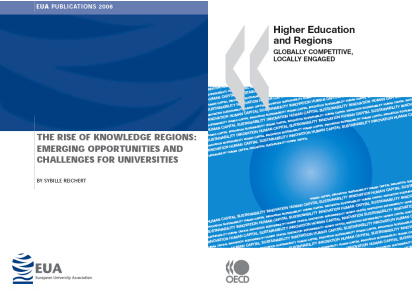Interregionalism and the Globalization of Higher Education
archive

Interregionalism and the Globalization of Higher Education
One of the interesting aspects of change in higher education systems is how they are being denationalized; reshaped, as it were, by forces and actors that are thinking at, and operating at, scales other than the national. In social science terms (e.g., see the work of Neil Brenner) this is often deemed the “relativization of scale”; the process whereby actors operating at the global scale, the inter-regional (e.g., Europe-Asia) scale, the supranational regional (e.g., European, Asian) scale, the national scale (e.g., Germany), the subnational regional (e.g., Silicon Valley) scale, and the urban scale, all come to play increasingly important roles in shaping a “multiscalar” development process. See, for example, these two recent reports by the European University Association (EUA) and the OECD on higher education for regional development in a globalizing era:

In this case we have a regional stakeholder organization (the EUA), and a multilateral organization (the OECD), both framing development processes simultaneously at the urban, regional, and global scales, with the national scale present, though clearly not dominant. Don’t forget, as well, that the OECD is a creation of member states, and its global thinking is therefore animated by, and mediated by, the nation-state. This is a point Saskia Sassen has insightfully driven home, most recently in Territory, Authority, Rights: From Medieval to Global Assemblages (Princeton University Press, 2006).
On the higher education and research policy front one emerging phenomenon worth taking note of is interregional dialogue. For example there is a now a decade long series of formal Transatlantic Dialogues, anchored by the American Council on Education (ACE), the Association of Universities and Colleges of Canada (AUCC), and the European University Association (EUA). These meetings are always framed by ‘global’ thinking, but focus on achieving interregional objectives and enhanced understandings of what is going on on both sides of the Atlantic.
In this context the EUA announced, on 21 February, that it is partnering with the German Academic Exchange Service (DAAD), and the Netherlands Organisation for International Cooperation in Higher Education (Nuffic), to “establish an EU-Asia Higher Education Platform for European and Asian academics and policy makers”. This initiative is being facilitated by the European Commission’s Asia Link programme. As the EUA puts it, the purpose of the two-year project is to:
1) Provide a means for enhancing information exchange, dialogue, and cooperation in higher education and research between the two regions;
2) Develop best practices for institutional development and cooperation, and foster mobility of students and academics between the two regions;
3) Draw attention to the role and situation of universities in developing countries.
Throughout the course of 2008-9, a series of workshops and round tables in Asia and Europe will be organised, targeting institutional development and cooperation issues. Amongst the themes that are expected to be covered will be higher education governance and management, decentralisation, cooperation in graduate education, and interregional and inter-institutional cooperation in quality assurance.
On the higher education and research policy front one emerging phenomenon worth taking note of is interregional dialogue.
While this is a complement to other forms of engagement also underway, and it is only targeted at parts of Asia, it is a noteworthy one.
First, and most importantly, there is much to learn in Asia about European developments over the last ten years given that Europe is grappling with the ‘modernization’ of its higher education system at a regional scale, though in a manner that blurs scales of action and intent, and takes into account national sensitivities and differential capacities for statecraft.
Second, it differs from the nature of North America-Asia and Australasia-Asia engagement, both of which tend to be relatively more person to person (e.g., the Australian Scholarships, the Fulbright awards) or event-oriented (e.g., student recruitment fairs, the US University Presidents’ Delegation to Southeast Asia).
In contrast, the EU-Asia Higher Education Platform is a truly post-national/interregional initiative, of a programmatic nature, and with an associated development agenda that focuses on systemic change.
In addition, and tying back to the start of this entry, note the presence of the nation-state in enabling EU-Asia relations to be forged, both directly and indirectly. This initiative is one that will also inevitably be forced to grapple with huge national variations in Asian higher education systems, and the lack of institutional capacity to operate at a regional scale in Asia, with respect to higher education. Yet while nation-states in Asia have not (yet) prioritized the construction of a regional higher education imaginary, it is only a matter of time given the structural forces that are reshaping Asian societies and economies. The complexion of the changes that will eventually emerge, and the nature of the intra-Asia and Asia-Other dialogue(s) facilitating them, have really yet to be determined.



